How much history is required for a time series forecast model?
This is a problem-specific question that we can investigate by designing an experiment.
In this tutorial, you will discover the effect that history size has on the skill of an ARIMA forecast model in Python.
Specifically, in this tutorial, you will:
- Load a standard dataset and fit an ARIMA model.
- Design and execute a sensitivity analysis of the number of years of historic data to model skill.
- Analyze the results of the sensitivity analysis.
This will provide a template for performing a similar sensitivity analysis of historical data set size on your own time series forecasting problems.
Kick-start your project with my new book Time Series Forecasting With Python, including step-by-step tutorials and the Python source code files for all examples.
Let’s get started.
- Updated Aug/2017: Fixed a bug where the models were constructed on the raw data instead of the seasonally differenced version of the data. Thanks David Ravnsborg!
- Updated Jun/2018: Removed duplicated sentence. Thanks Rahul!
- Updated Apr/2019: Updated the link to dataset.
- Updated Aug/2019: Updated data loading to use new API.
- Updated Dec/2020: Updated ARIMA API to the latest version of statsmodels.
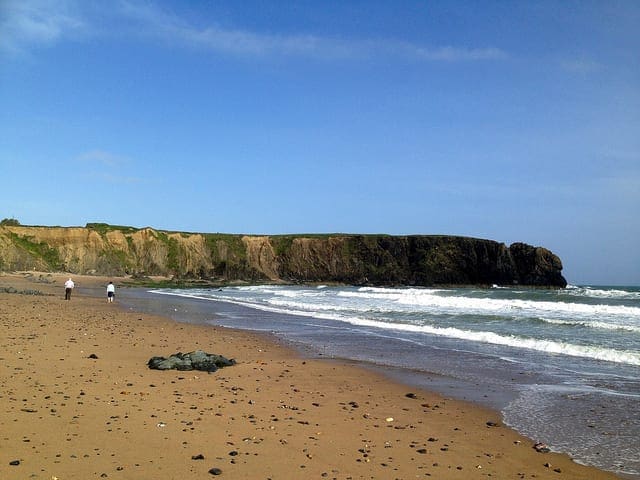
Sensitivity Analysis of History Size to Forecast Skill with ARIMA in Python
Photo by Sean MacEntee, some rights reserved.
Minimum Daily Temperatures Dataset
This dataset describes the minimum daily temperatures over 10 years (1981-1990) in the city of Melbourne, Australia.
The units are in degrees Celsius and there are 3,650 observations. The source of the data is credited as the Australian Bureau of Meteorology.
Download the dataset and save it in your current working directory with the filename “daily-minimum-temperatures.csv“.
The example below loads the dataset as a Pandas Series.
|
1 2 3 4 5 6 7 8 9 10 |
# line plot of time series from pandas import read_csv from matplotlib import pyplot # load dataset series = read_csv('daily-minimum-temperatures.csv', header=0, index_col=0) # display first few rows print(series.head(20)) # line plot of dataset series.plot() pyplot.show() |
Running the example prints the first 20 rows of the loaded file.
|
1 2 3 4 5 6 7 8 9 10 11 12 13 14 15 16 17 18 19 20 21 22 |
Date 1981-01-01 20.7 1981-01-02 17.9 1981-01-03 18.8 1981-01-04 14.6 1981-01-05 15.8 1981-01-06 15.8 1981-01-07 15.8 1981-01-08 17.4 1981-01-09 21.8 1981-01-10 20.0 1981-01-11 16.2 1981-01-12 13.3 1981-01-13 16.7 1981-01-14 21.5 1981-01-15 25.0 1981-01-16 20.7 1981-01-17 20.6 1981-01-18 24.8 1981-01-19 17.7 1981-01-20 15.5 Name: Temp, dtype: float64 |
Then the data is graphed as a line plot showing the seasonal pattern.
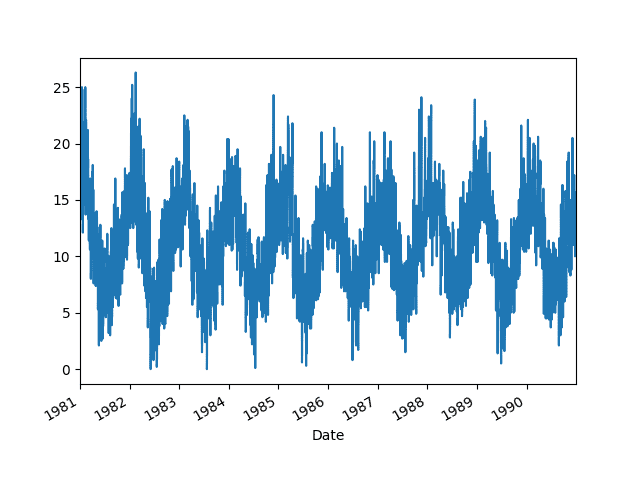
Minimum Daily Temperatures Dataset Line Plot
ARIMA Forecast Model
In this section, we will fit an ARIMA forecast model to the data.
The parameters of the model will not be tuned, but will be skillful.
The data contains a one-year seasonal component that must be removed to make the data stationary and suitable for use with an ARIMA model.
We can take the seasonal difference by subtracting the observation from one year ago (365 days). This is rough in that it does not account for leap years. It also means that the first year of data will be unavailable for modeling as there is no data one year before to difference the data.
|
1 2 3 4 |
# seasonal difference differenced = series.diff(365) # trim off the first year of empty data differenced = differenced[365:] |
We will fit an ARIMA(7,0,0) model to the data and print the summary information. This demonstrates that the model is stable.
|
1 2 3 4 |
# fit model model = ARIMA(differenced, order=(7,0,0)) model_fit = model.fit() print(model_fit.summary()) |
Putting this all together, the complete example is listed below.
|
1 2 3 4 5 6 7 8 9 10 11 12 13 14 |
# fit an ARIMA model from pandas import read_csv from matplotlib import pyplot from statsmodels.tsa.arima.model import ARIMA # load dataset series = read_csv('daily-minimum-temperatures.csv', header=0, index_col=0) # seasonal difference differenced = series.diff(365) # trim off the first year of empty data differenced = series[365:] # fit model model = ARIMA(differenced, order=(7,0,0)) model_fit = model.fit() print(model_fit.summary()) |
Running the example provides a summary of the fit ARIMA model.
|
1 2 3 4 5 6 7 8 9 10 11 12 13 14 15 16 17 18 19 20 21 22 23 24 25 26 27 28 29 30 31 |
ARMA Model Results ============================================================================== Dep. Variable: Temp No. Observations: 3285 Model: ARMA(7, 0) Log Likelihood -8690.089 Method: css-mle S.D. of innovations 3.409 Date: Fri, 25 Aug 2017 AIC 17396.178 Time: 15:02:59 BIC 17444.955 Sample: 01-01-1982 HQIC 17413.643 - 12-31-1990 ============================================================================== coef std err z P>|z| [0.025 0.975] ------------------------------------------------------------------------------ ar.L1.Temp 0.5278 0.017 30.264 0.000 0.494 0.562 ar.L2.Temp -0.1099 0.020 -5.576 0.000 -0.149 -0.071 ar.L3.Temp 0.0286 0.020 1.441 0.150 -0.010 0.067 ar.L4.Temp 0.0307 0.020 1.549 0.122 -0.008 0.070 ar.L5.Temp 0.0090 0.020 0.456 0.648 -0.030 0.048 ar.L6.Temp 0.0164 0.020 0.830 0.407 -0.022 0.055 ar.L7.Temp 0.0272 0.017 1.557 0.120 -0.007 0.061 Roots ============================================================================= Real Imaginary Modulus Frequency ----------------------------------------------------------------------------- AR.1 1.3305 -0.0000j 1.3305 -0.0000 AR.2 0.9936 -1.1966j 1.5553 -0.1397 AR.3 0.9936 +1.1966j 1.5553 0.1397 AR.4 -0.2067 -1.7061j 1.7186 -0.2692 AR.5 -0.2067 +1.7061j 1.7186 0.2692 AR.6 -1.7536 -0.8938j 1.9683 -0.4250 AR.7 -1.7536 +0.8938j 1.9683 0.4250 ----------------------------------------------------------------------------- |
Model History Sensitivity Analysis
In this section, we will explore the effect that history size has on the skill of the fit model.
The original data has 10 years of data. Seasonal differencing leaves us with 9 years of data. We will hold back the final year of data as test data and perform walk-forward validation across this final year.
The day-by-day forecasts will be collected and a root mean squared error (RMSE) score will be calculated to indicate the skill of the model.
The snippet below separates the seasonally adjusted data into training and test datasets.
|
1 |
train, test = differenced[differenced.index < '1990'], differenced['1990'] |
It is important to choose an interval that makes sense for your own forecast problem.
We will evaluate the skill of the model with the previous 1 year of data, then 2 years, all the way back through the 8 available years of historical data.
A year is a good interval to test for this dataset given the seasonal nature of the data, but other intervals could be tested, such as month-wise or multi-year intervals.
The snippet below shows how we can step backwards by year and cumulatively select all available observations.
For example
- Test 1: All data in 1989
- Test 2: All data in 1988 to 1989
And so on.
|
1 2 3 4 5 6 |
# split train, test = differenced[differenced.index < '1990'], differenced['1990'] years = ['1989', '1988', '1987', '1986', '1985', '1984', '1983', '1982'] for year in years: # select data from 'year' cumulative to 1989 dataset = train[train.index >= year] |
The next step is to evaluate an ARIMA model.
We will use walk-forward validation. This means that a model will be constructed on the selected historic data and forecast the next time step (Jan 1st 1990). The real observation for that time step will be added to the history, a new model constructed, and the next time step predicted.
The forecasts will be collected together and compared to the final year of observations to give an error score. In this case, RMSE will be used as the scores and will be in the same scale as the observations themselves.
|
1 2 3 4 5 6 7 8 9 10 11 12 13 14 15 |
# walk forward over time steps in test values = dataset.values history = [values[i] for i in range(len(values))] predictions = list() test_values = test.values for t in range(len(test_values)): # fit model model = ARIMA(history, order=(7,0,0)) model_fit = model.fit() # make prediction yhat = model_fit.forecast()[0] predictions.append(yhat) history.append(test_values[t]) rmse = sqrt(mean_squared_error(test_values, predictions)) print('%s-%s (%d values) RMSE: %.3f' % (years[0], year, len(values), rmse)) |
Putting this all together, the complete example is listed below.
|
1 2 3 4 5 6 7 8 9 10 11 12 13 14 15 16 17 18 19 20 21 22 23 24 25 26 27 28 29 30 31 32 33 |
# fit an ARIMA model from pandas import read_csv from matplotlib import pyplot from statsmodels.tsa.arima.model import ARIMA from sklearn.metrics import mean_squared_error from math import sqrt # load dataset series = read_csv('daily-minimum-temperatures.csv', header=0, index_col=0) # seasonal difference differenced = series.diff(365) # trim off the first year of empty data differenced = differenced[365:] # split train, test = differenced[differenced.index < '1990'], differenced['1990'] years = ['1989', '1988', '1987', '1986', '1985', '1984', '1983', '1982'] for year in years: # select data from 'year' cumulative to 1989 dataset = train[train.index >= year] # walk forward over time steps in test values = dataset.values history = [values[i] for i in range(len(values))] predictions = list() test_values = test.values for t in range(len(test_values)): # fit model model = ARIMA(history, order=(7,0,0)) model_fit = model.fit() # make prediction yhat = model_fit.forecast()[0] predictions.append(yhat) history.append(test_values[t]) rmse = sqrt(mean_squared_error(test_values, predictions)) print('%s-%s (%d values) RMSE: %.3f' % (years[0], year, len(values), rmse)) |
Running the example prints the interval of history, number of observations in the history, and the RMSE skill of the model trained with that history.
The example does take awhile to run as 365 ARIMA models are created for each cumulative interval of historic training data.
|
1 2 3 4 5 6 7 8 |
1989-1989 (365 values) RMSE: 3.120 1989-1988 (730 values) RMSE: 3.109 1989-1987 (1095 values) RMSE: 3.104 1989-1986 (1460 values) RMSE: 3.108 1989-1985 (1825 values) RMSE: 3.107 1989-1984 (2190 values) RMSE: 3.103 1989-1983 (2555 values) RMSE: 3.099 1989-1982 (2920 values) RMSE: 3.096 |
The results show that as the size of the available history is increased, there is a decrease in model error, but the trend is not purely linear.
We do see that there may be a point of diminishing returns at 2-3 years. Knowing that you can use fewer years of data is useful in domains where data availability or long model training time is an issue.
We can plot the relationship between ARIMA model error and the number of training observations.
|
1 2 3 4 5 |
from matplotlib import pyplot x = [365, 730, 1095, 1460, 1825, 2190, 2555, 2920] y = [3.120, 3.109, 3.104, 3.108, 3.107, 3.103, 3.099, 3.096] pyplot.plot(x, y) pyplot.show() |
Running the example creates a plot that almost shows a linear trend down in error as training samples increases.
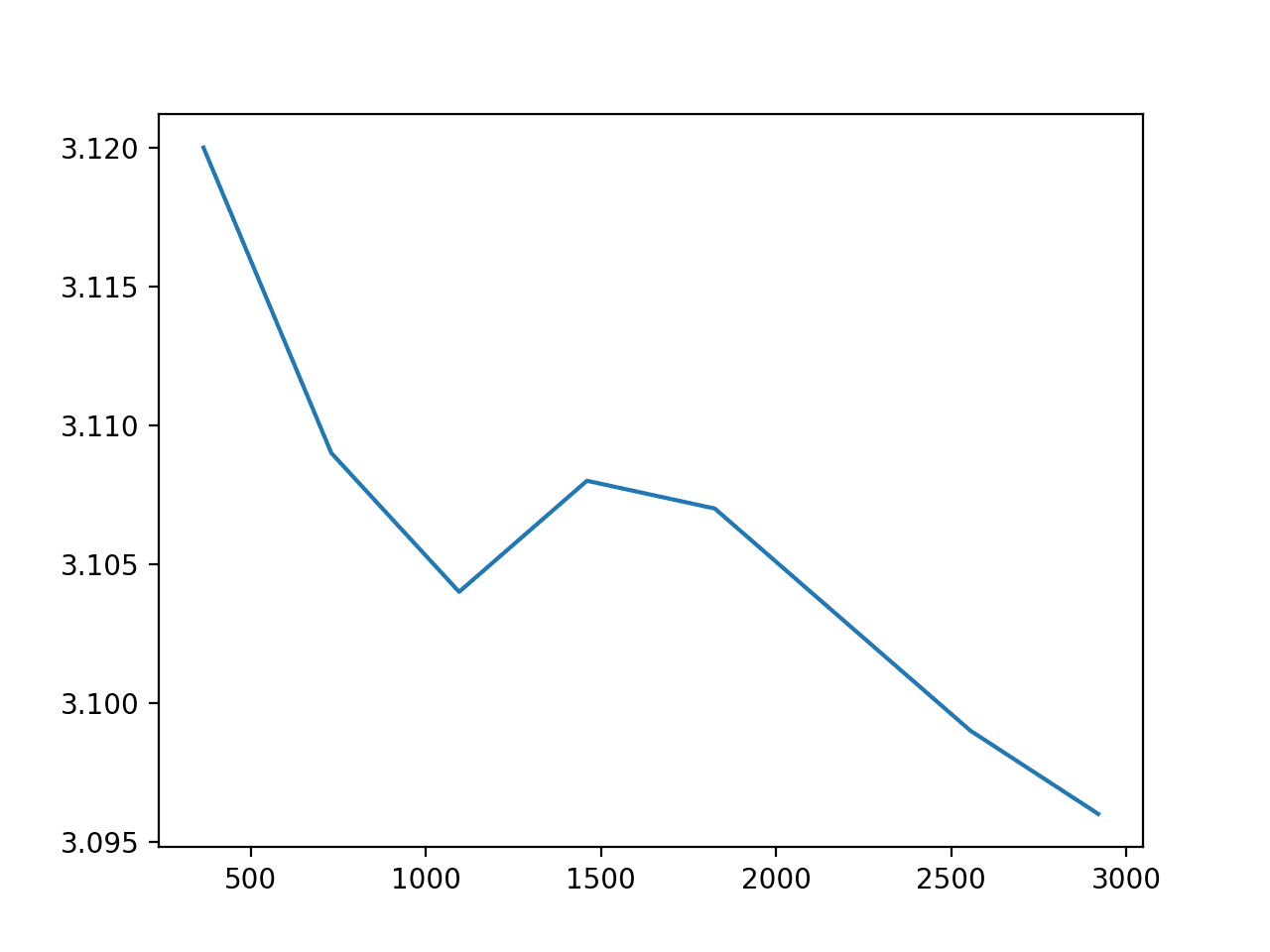
History Size vs ARIMA Model Error
This is generally expected, as more historical data means that the coefficients may be better optimized to describe what happens with the variability from more years of data, for the most part.
There is also a counter-intuition. One may expect the performance of the model to increase with more history, as the data from the most recent years may be more like the data next year. This intuition is perhaps more valid in domains subjected to greater concept drift.
Extensions
This section discusses limitations and extensions to the sensitivity analysis.
- Untuned Model. The ARIMA model used in the example is by no means tuned to the problem. Ideally, a sensitivity analysis of the size of training history would be performed with an already tuned ARIMA model or a model tuned to each case.
- Statistical Significance. It is not clear whether the difference in model skill is statistically significant. Pairwise statistical significance tests can be used to tease out whether differences in RMSE are meaningful.
- Alternate Models. The ARIMA uses historical data to fit coefficients. Other models may use the increasing historical data in other ways. Alternate nonlinear machine learning models may be investigated.
- Alternate Intervals. A year was chosen to joint the historical data, but other intervals may be used. A good interval might be weeks or months within one or two years of historical data for this dataset, as the extreme recency may bias the coefficients in useful ways.
Summary
In this tutorial, you discovered how you can design, execute, and analyze a sensitivity analysis of the amount of history used to fit a time series forecast model.
Do you have any questions?
Ask your questions in the comments and I’ll do my best to answer.

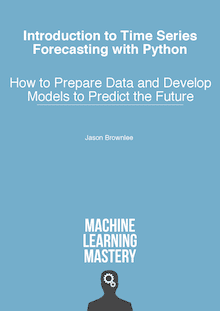
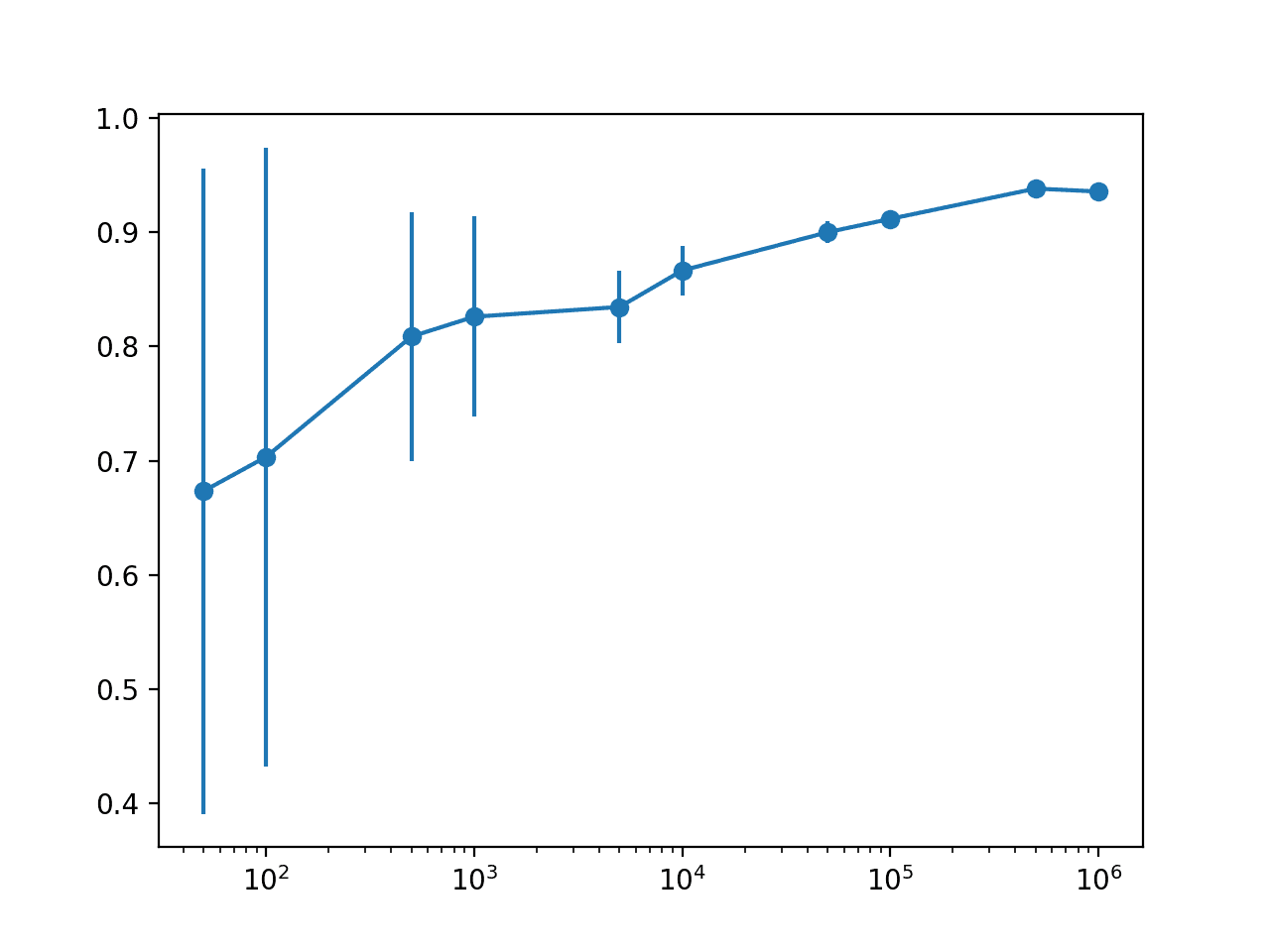
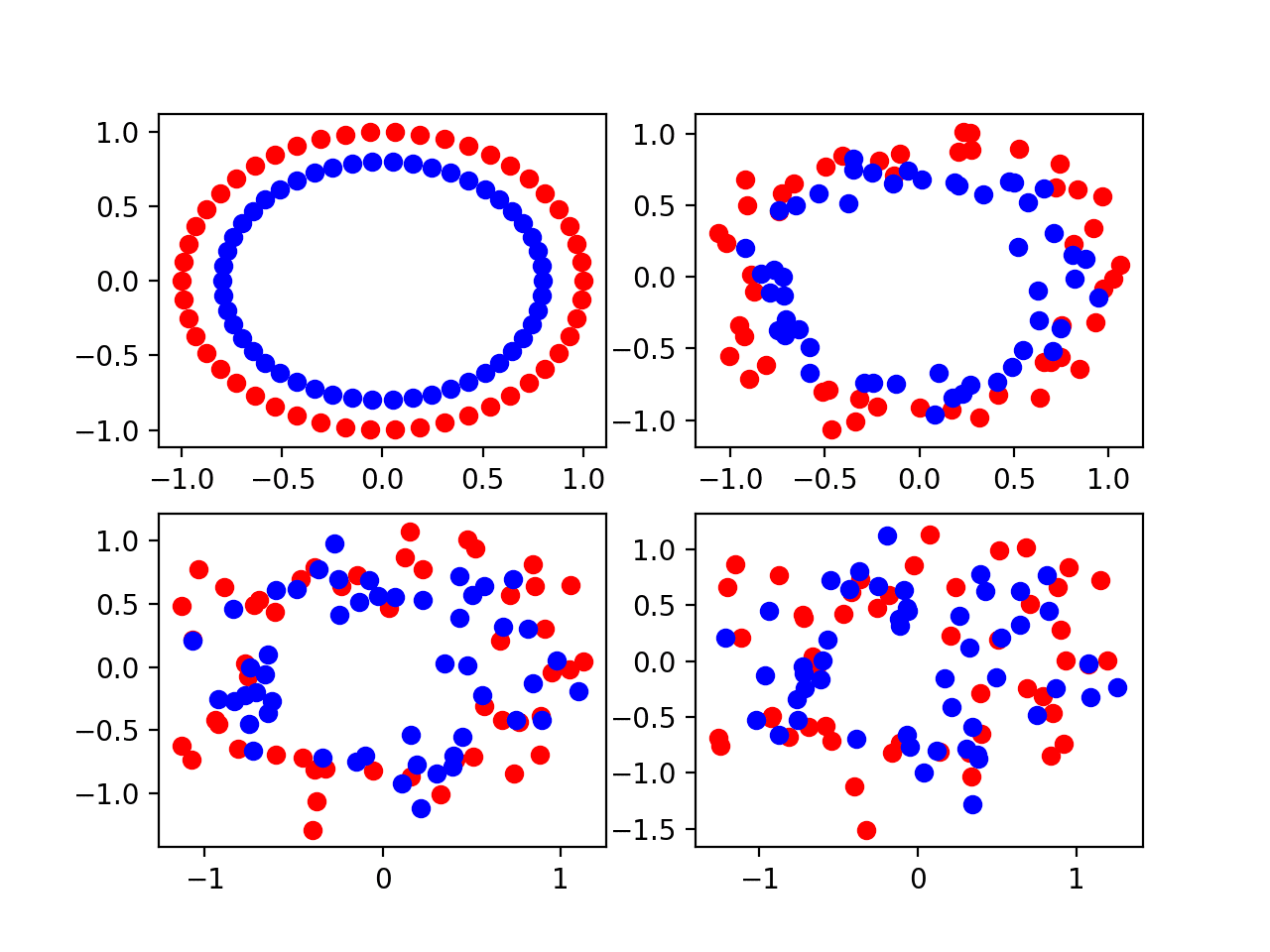
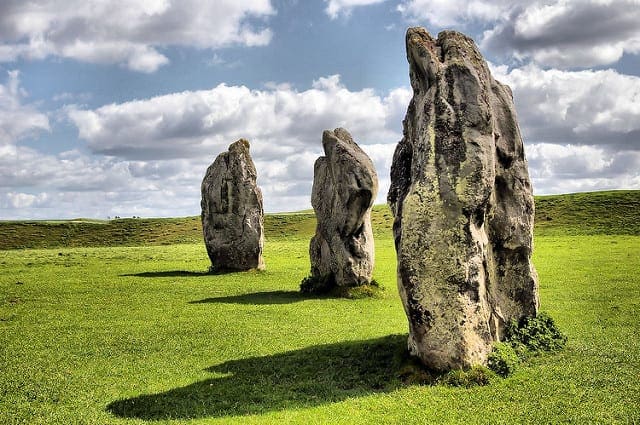

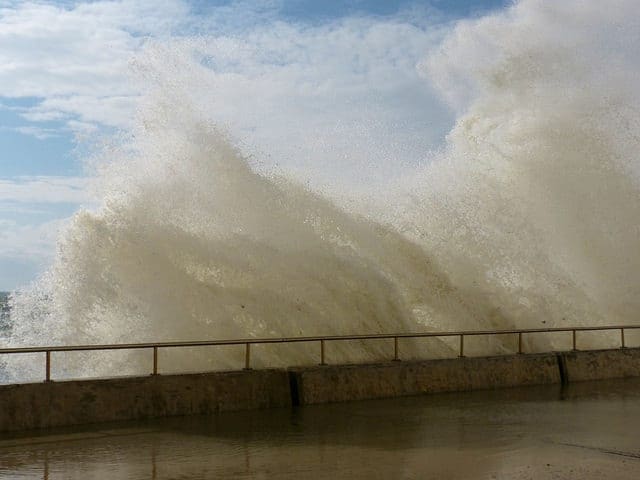

thank you ! but, can you give me a download address of dataset? i want to try again!
thank!
Sorry, here it is:
https://datamarket.com/data/set/2324/daily-minimum-temperatures-in-melbourne-australia-1981-1990
Good afternoon!
Thank you for your article.
Tell me please, if there are more formal and mathematical definitions of sensitivity analysis of history size to forecast?
Or is this usually only an experimental way of determining?
Thank you!
I’m sure you can analyze the effect of history size on the model analytically.
A sensitivity analysis seeks to answer the question empirically.
Why do you declare “differenced” and then immediately write over it without using it?
Good question, that looks like a bug to me. I’ll add a note to trello to fix it up.
I looked into it a little further on my end. I think it was just a typo where:
# seasonal difference
differenced = series.diff(365)
# trim off the first year of empty data
differenced = series[365:]
should have been…
# seasonal difference
differenced = series.diff(365)
# trim off the first year of empty data
differenced = differenced[365:]
But it completely changes the results for the worse 🙁 Any chance you could cover this? It would make a great follow-up. Here are the results I get:
model.py:496: ConvergenceWarning: Maximum Likelihood optimization failed to converge. Check mle_retvals
“Check mle_retvals”, ConvergenceWarning)
1989-1989 (365 values) RMSE: 3.120
1989-1988 (730 values) RMSE: 3.109
model.py:496: ConvergenceWarning: Maximum Likelihood optimization failed to converge. Check mle_retvals
“Check mle_retvals”, ConvergenceWarning)
1989-1987 (1095 values) RMSE: 3.104
1989-1986 (1460 values) RMSE: 3.108
1989-1985 (1825 values) RMSE: 3.107
model.py:496: ConvergenceWarning: Maximum Likelihood optimization failed to converge. Check mle_retvals
“Check mle_retvals”, ConvergenceWarning)
1989-1984 (2190 values) RMSE: 3.103
1989-1983 (2555 values) RMSE: 3.099
1989-1982 (2920 values) RMSE: 3.096

I have updated the post, thanks again David.
We still see the same linearly downward trend in error.
Remember that the RMSE scores are in fact in the units of seasonally differenced temperatures. This may make a difference.
If you’re interested in better results, you can try using a grid search on the ARIMA parameters to see if we can do better than ARIMA(7,0,0) or whether performing a seasonal difference results in better final RMSE on this problem.
Hey Jason,
Just a minor edit.
Ctrl+F “The day-by-day forecasts will be collected and a root” and the sentence has been repeated twice. Not an issue but thought you’d like to know.
Awesome posts, I really enjoy reading your work 🙂
Thanks, fixed.
I checked Stationarity test for the provided dataset using Augmented Dickey-Fuller method and below is the result
Test Statistic -4.445747
p-value 0.000246
#Lags Used 20.000000
Number of Observations Used 3629.000000
Critical Value (1%) -3.432153
Critical Value (5%) -2.862337
Critical Value (10%) -2.567194
based on the result i conclude that data looks very much stationary and
I have a question that even though data is stationary Why did you apply Seasonality dereference ?
What dataset did you evaluate exactly?
The temperature dataset clearly has a time dependent structure.
I evaluated “daily-minimum-temperatures.csv” dataset (same dataset used in this article).
but ADF result (copied in last comment) shows data looks stationary.
suppose i want to predict sales in a region based on date and that day temperature( based on temperature like too cold my sales will impact). Please let me know if arima can be used here
Perhaps try it and discover how well it works.
hi,tks for your blog. i’m newbie, sorry for not good english, can you explain the value in ARIMA model results, i don’t know what the value of AIC, BIC,HQIC and coef,std err,z,P>|z|,…means? And how do know it is a good results?
Good question, perhaps this will help:
https://machinelearningmastery.com/faq/single-faq/how-to-know-if-a-model-has-good-performance
Great tutorial!. One question about the methodology – you indicated “we can step backwards by year and cumulatively select all available observations”. Is there a reason to step backwards (from 1989 to 1982) instead of stepping forward [from 1982 to 1989, eg. (Test 1) All data in 1982, (Test 2) Test 2: All data in 1982 to 1983, etc.]?
Thanks.
We step forward when evaluating, I was explaining how we expand the window. Sorry for the confusion.
Hello Jason.
Do you have, any example using logarithm on the time series?
Yes, right here:
https://machinelearningmastery.com/power-transform-time-series-forecast-data-python/